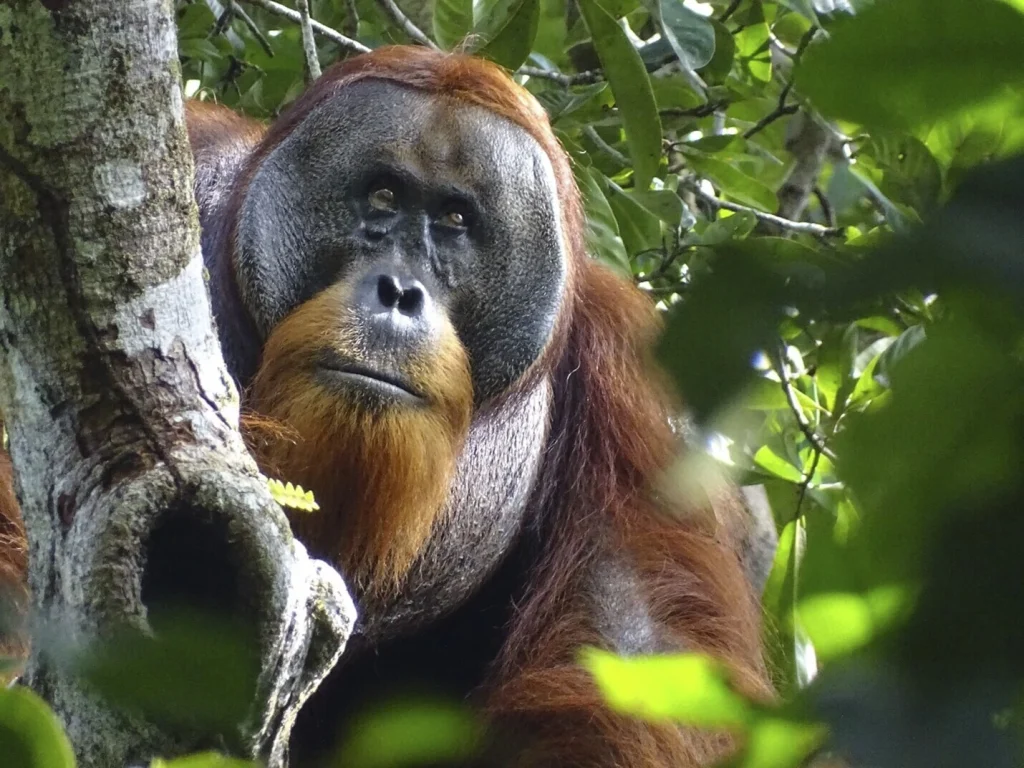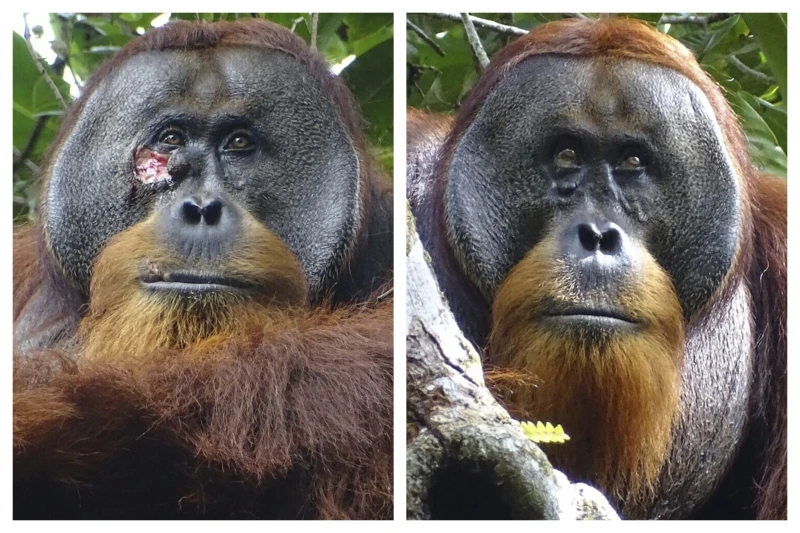In a remarkable observation that underscores the complex interplay between animal behavior and the natural environment, researchers have documented an orangutan named Rakus exhibiting self-medication behaviors by utilizing a medicinal plant to treat a wound.
This phenomenon, which has been observed in various species, raises significant questions about animal cognition, the understanding of natural remedies, and the implications for conservation efforts.
The findings, recently published in Scientific Reports, not only contribute to our understanding of orangutan behavior but also highlight the broader implications of self-medication in the animal kingdom.
The observation of Rakus, an adult male orangutan residing in Indonesia’s Gunung Leuser National Park, was made by Ulil Azhari, a field researcher with the Suaq Project.
In 2022, Azhari documented Rakus plucking and chewing leaves from a medicinal plant known for its pain-relieving and anti-inflammatory properties, which has been traditionally used by humans across Southeast Asia.
Following the mastication of the leaves, Rakus applied the plant’s juices directly to a wound on his right cheek, subsequently using the chewed leaves as a makeshift bandage.
Remarkably, photographs taken during this period reveal that the wound healed without complications within a month.
The significance of this behavior cannot be overstated. While earlier studies have recorded instances of self-medication among various species of great apes foraging for natural remedies, the direct application of a medicinal plant to a wound represents a novel observation.
As co-author Isabelle Laumer, a biologist at the Max Planck Institute of Animal Behavior, states, “This is the first time that we have observed a wild animal applying a quite potent medicinal plant directly to a wound.”
This statement encapsulates the essence of the study: it not only documents a unique behavior but also challenges existing notions about the cognitive capabilities of non-human animals.
The implications of Rakus’s behavior extend beyond mere observation; they prompt a reevaluation of the cognitive and learning capabilities of orangutans and other species.
Emory University biologist Jacobus de Roode, who was not involved in the study, aptly notes that “often we learn about new behaviors by starting with a single observation.”
This observation opens avenues for further research into how animals acquire knowledge about medicinal plants, whether through social learning from peers or through individual exploration.
It raises the possibility that Rakus may have learned this technique from other orangutans living outside the park, demonstrating the potential for cultural transmission of knowledge among non-human species.
The ability to self-medicate is not limited to orangutans; it has been documented in a variety of species, including chimpanzees, dogs, and even certain bird species.
These behaviors often involve the ingestion of specific plants known to possess medicinal properties, suggesting a level of awareness regarding the therapeutic effects of these substances.
Such behaviors challenge the anthropocentric view of medicine, emphasizing that the natural world may hold a wealth of knowledge regarding healing that is yet to be fully understood.
In addition to its implications for understanding animal behavior, this study has significant conservation ramifications. Orangutans are currently facing numerous threats, including habitat destruction, poaching, and the illegal pet trade.
As their populations dwindle, understanding their behaviors and interactions with their environment becomes increasingly crucial.
Observations like those of Rakus not only enrich our understanding of orangutan ecology but also highlight the importance of preserving their natural habitats, where they can continue to engage in behaviors that are essential for their survival.
Moreover, the study emphasizes the need for a comprehensive approach to conservation that considers the cognitive and behavioral complexities of wildlife.
By acknowledging the capacity for self-medication and other sophisticated behaviors, conservationists can foster a deeper appreciation for the intrinsic value of these animals and their habitats.
This understanding may encourage more effective conservation strategies that prioritize the preservation of ecosystems that support the natural behaviors of orangutans and other wildlife.
The case of Rakus, an orangutan whose life began beyond the confines of the designated study area, presents a compelling narrative that underscores the intricate interplay between primate behavior and the utilization of natural resources for self-medication.
It is postulated by researchers that Rakus sustained injuries, potentially incurred during a confrontation with another animal, raising the question of whether these wounds were isolated occurrences or part of a more extensive history of prior injuries that may have required remedial attention.
This circumstance invites a broader examination of self-medicative behaviors observed among various primate species, which have been documented employing plant-based remedies to alleviate ailments and, in some cases, to enhance their overall well-being.
Noteworthy examples include the Bornean orangutans, who have been observed rubbing their bodies with the exudates of certain medicinal plants, an action that may serve dual purposes: to mitigate bodily discomfort or to repel parasitic foes.
Similarly, chimpanzees across diverse habitats exhibit a habitual proclivity for masticating the bitter shoots of specific flora, ostensibly to quell gastrointestinal disturbances, while gorillas, chimpanzees, and bonobos have been recorded ingesting coarse leaves to purge their systems of stomach parasites.
The prevalence of such behaviors raises profound inquiries into the evolutionary pathways of medicinal practices and the innate capabilities of these species to interact with their ecological surroundings for therapeutic benefits.

As articulated by Tara Stoinski, president and chief scientific officer of the Dian Fossey Gorilla Fund, although she was not involved in the present study, the existence of these self-medicative behaviors among our closest living relatives provokes intriguing hypotheses regarding the origins of medicinal knowledge and practices, prompting further exploration into the evolutionary significance and adaptive advantages of such behaviors in the wildlife realm.
In conclusion, the observation of Rakus using a medicinal plant to treat his wound is a groundbreaking discovery that sheds light on the self-medication behaviors of orangutans.
This unique instance not only enriches our understanding of animal behavior and cognition but also underscores the importance of conservation efforts aimed at protecting these remarkable creatures and their habitats.
As we continue to study and learn from the natural world, it is imperative that we recognize the intricate relationships between species and their environments, fostering a greater respect for the complexities of life that exist beyond human understanding.
The behavior exhibited by Rakus is a testament to the intelligence and adaptability of orangutans, reminding us of the profound connections that exist within the tapestry of the natural world.
